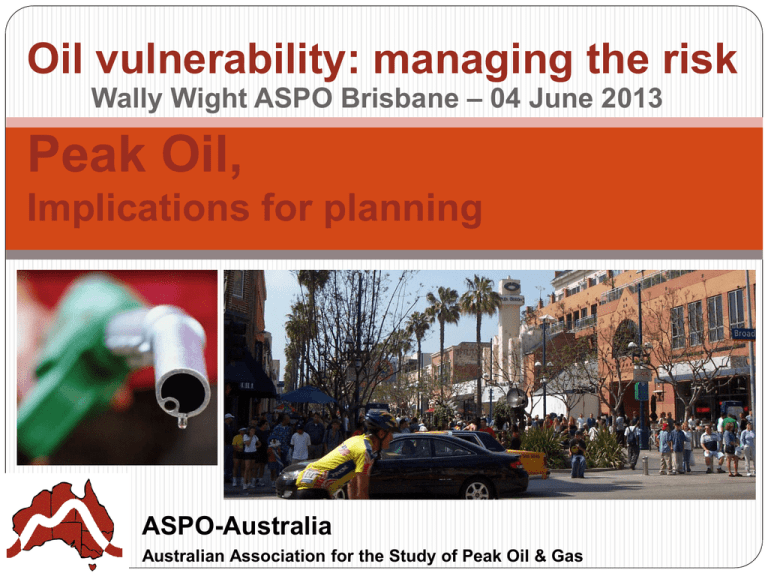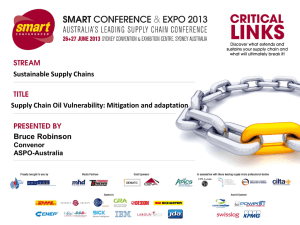Slides - ASPO Australia
advertisement

Oil vulnerability: managing the risk Wally Wight ASPO Brisbane – 04 June 2013 Peak Oil, Implications for planning ASPO-Australia Australian Association for the Study of Peak Oil & Gas Oil depletion’s impact on human settlement is not new Global discovery peaked in 1964 USA production peaked in 1971 Canada (once considered inexhaustible) peaked in 1973 Australia peaked in 2000 I only became aware of peak oil (though not by that name) nearly 60 years ago by land use change when my first school closed due to a lack of students. The Turner Valley Oilfield, Alberta, Canada (scene of my childhood and a microcosm of the global scene), had peaked 15 years before. ASPO-Australia Australian Association for the Study of Peak Oil & Gas The Turner Valley Oil Rush 14 May 1914, Dingman No 1 blew in: It hit pay dirt at 800 metres depth yielding 400 000 cu m/day of natural gas pushing out a gusher of oil Within 24 hours, promoters had formed more than 500 oil companies! ASPO-Australia Australian Association for the Study of Peak Oil & Gas Community development ASPO-Australia During the “boom”, a string of “shantytowns” mushroomed: Naptha Glen Mede (my first school) Hartell Mercury Little Chicago (Royalties) population 1350 Little New York (Longview) Australian Association for the Study of Peak Oil & Gas Use and Abuse: “Hell’s half-acre” Up to the 1940’s, Turner Valley had been the most productive field in the entire British Empire: 25 000 barrels of oil/day 20 million Cu M of gas/day Gas had little market value and the “excess” (enough to satisfy New York City’s energy needs) was simply burned off in massive flares. Production peaked in 1940. ASPO-Australia Australian Association for the Study of Peak Oil & Gas Changing Technologies After the peak: 1950’s reduced gas pressure meant pumps were required Automation reduced labour demand, resulting in job losses and depopulation. 1960’s depeted oil levels were addressed by water injection. 1970’s more wells and pumps were introduced to extract from increasingly isolated pockets. Current flurry of horizontal drilling and new pumping technology. ASPO-Australia Australian Association for the Study of Peak Oil & Gas Community deconstruction “Rural renewal” of townships Naptha Glen Mede Hartell Mercury (refinery explosion in 1951) Royalties All reconverted to farmland ASPO-Australia Longview the only survivor Australian Association for the Study of Peak Oil & Gas Lessons from this past experience: Oil depletion is real, and already happening. Wastage and excesses make the impacts orders of magnitude worse. We need to recognise that it is happening. We need to curb our wastage and excess early to minimise the impact. 70+ years post-peak, there is still oil to be had from Turner Valley, but progressively lower in volume and more difficult and expensive to extract. Globally, we are already very late in preparing and responding to the end of cheap oil. ASPO-Australia Australian Association for the Study of Peak Oil & Gas So when do we have to act? If a crash program to reduce oil use or to switch from oil to renewable energy had begun: 20 years before Peak Oil (from 1986?): Possibility of avoiding a world liquid fuels shortfall for the forecast period. Slight economic disruptions. 10 years before Peak Oil (from 1996?): Liquid fuels shortfall for roughly a decade after the time that oil would have peaked. Moderate economic disruptions. 0 years before Peak Oil (from 2006?): Significant liquid fuel deficit for more than two decades. Severe economic disruptions (as started in 2008? 2nd dip soon?) ASPO-Australia Australian Association for the Study of Peak Oil & Gas Current switch to “unconventionals” Already, we are relying more on unconventional sources, and are now facing the risks and consequences. Actual 1999 BP advertisement ASPO-Australia Australian Association for the Study of Peak Oil & Gas Can alternative fuels help? ASPO-Australia Australian Association for the Study of Peak Oil & Gas Likely Oil Depletion “Events” 1. Sudden critical supply interruption Sharp price rises Reduced availability of supply (queueing, rationing) 2. Intermittent supply constraints Volatile price fluctuations (our experience of the last five years), and/or Sharp volatility of demand affected by price (ditto) 3. Progressive supply constraints global increase in demand competition Increased retention of reserves by exporters, and associated price rises (CSIRO models $8.00/litre) ASPO-Australia Australian Association for the Study of Peak Oil & Gas Transport is dependent on oil Australia’s oil consumption: 72% for transport 8.5% for mining 7.1% for chemicals Oil-based plastics are Highly vulnerable Toxic and non-recyclable Minimal local value capture 4.8% for agriculture Transport is over 90% oil dependent ASPO-Australia Australian Association for the Study of Peak Oil & Gas Energy consumed by vehicles (Qld) More than half of energy is consumed by private passenger cars Trucks and light commercial vehicles share most of the balance ASPO-Australia Australian Association for the Study of Peak Oil & Gas Australia relies disproportionately on road transport . In spite of increasing vulnerability, the proportion of freight taken on trucks is actually growing. Our dispersed population and economic activity makes the flexibility of trucking compelling. Transport infrastructure investment tends to favour roads to facilitate increased road freight. ASPO-Australia Australian Association for the Study of Peak Oil & Gas Our communities are at risk For any decision regarding capital expenditure or operations: Will this initiative exacerbate oil vulnerability? Or will it reduce vulnerability? The viability and sustainability of our communities’ are at stake. ASPO-Australia Australian Association for the Study of Peak Oil & Gas We can’t simply build our way out of oil vulnerability . Reliance on more ASPO-Australia infrastructure as a possible solution is problematic. Conventional construction of transport infrastructure is still very oil intensive in both materials and machinery Australian Association for the Study of Peak Oil & Gas So how can we respond? Identify and quantify oil usage in each sector and operation, Identify vulnerable activities and processes, Review how critical those vulnerable activities and processes are, then Assess the risks and consequences of the oil depletion events. ASPO-Australia Australian Association for the Study of Peak Oil & Gas . We require a transformation From: Sprawling, Car-based monocultures To: Functionally diverse, Locally self-reliant, Economically productive, Socially inclusive, Energy and water ASPO-Australia efficient, Less carbon intensive, and More resilient settlement patterns Australian Association for the Study of Peak Oil & Gas Post-Peak, How will we exchange goods and services? . ASPO-Australia Australian Association for the Study of Peak Oil & Gas Choice of transit modes Walking and cycling are most sustainable; Buses, trams and trains carry people more efficiently and amenably than cars do...and can share the public realm; Ferries (or kayaks) turn the rivers and the Bay from barriers to connectors …and make transit an absolute pleasure! ASPO-Australia Australian Association for the Study of Peak Oil & Gas Integrate home and vehicle energy . Using domestic solar ASPO-Australia to charge the car frees us from hydrocarbons Energy storage in the car’s battery addresses one of the key challenges of domestic solar The effectiveness of the combination will depend on when the car is being charged and when used. Australian Association for the Study of Peak Oil & Gas Goods and Services can be Produced and Exchanged Locally . Integration of land use to minimise transport - (compact, accessible and permeable mixed-use centres to live, work and play, requiring minimum motorised travel) Use public transport, walking and cycling Buy local – reduce commodity kilometres Substitute oil-dependent products in favour of renewable and local alternatives Get used to living with less – human exchange is more important than commodity exchange. ASPO-Australia Australian Association for the Study of Peak Oil & Gas Designing our Urban “places” Our cities and “places” must support human exchange …not just “keep the vehicles moving”. We live in cities to maximise exchange with a minimum of travel. Only at the pedestrian scale and at pedestrian pace, is valuable human exchange possible. Reducing reliance on vehicles not only reduces oil vulnerability, but will help our cities function. ASPO-Australia Australian Association for the Study of Peak Oil & Gas What can place-based planning do? ASPO-Australia Identify opportunities to reduce vulnerability Reinforce land use to minimise travel (the most economical trip is the trip not taken) Change modes, Change logistics, Substitute less vulnerable activities and processes, Find efficiencies and economies for activities and processes that cannot be avoided Find alternative energies or fuels Australian Association for the Study of Peak Oil & Gas Social and Land use Responses Transport vulnerability is addressed by nontransport solutions TOD: Co-location and intensification of diverse land uses Localisation and selfcontainment of employment, supply chains, production, and economic activity ASPO-Australia Australian Association for the Study of Peak Oil & Gas Local government’s role Some Councils have taken the initiative to address vulnerability of not just their own operations, but also their communities. Maribyrnong, Vic Sterling, WA Sunshine Coast, Qld Gold Coast, Qld ASPO-Australia Australian Association for the Study of Peak Oil & Gas Statutory support was emerging . Towards Q2 2020 Target: Cut by one-third Queenslanders’ carbon footprint with reduced car and electricity use Qld Government had adopted an oil vulnerability report and was preparing an Oil Vulnerability Strategy FNQ and SEQ Regional Plans require oil vulnerability to be addressed – but will these provisions survive? ASPO-Australia Australian Association for the Study of Peak Oil & Gas …and professional interest ASPO has long supported initiatives to raise awareness (eg. Brisbane Chapter locally-produced movie “Australia Pumping Empty”) The Planning Institute of Australia dedicated its December 2010 Australian Planner issue to peak oil and is preparing a book of the findings, ASPO Brisbane and Griffith University are hosting this oil vulnerability symposium. So the oil vulnerability issue is gaining credence and traction… ASPO-Australia Australian Association for the Study of Peak Oil & Gas Conclusions What we must do to respond to peak oil is exactly what must be done for urban transformation Transition is an awesome responsibility Are we ready? ASPO-Australia Australian Association for the Study of Peak Oil & Gas Thank you Wally Wight wwight@gil.com.au 0417 741 377 Coordinator Brisbane Chapter ASPO Australia Adjunct Senior Research Fellow Curtin University Sustainability Policy (CUSP) Institute ASPO-Australia Australian Association for the Study of Peak Oil & Gas








